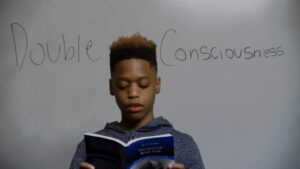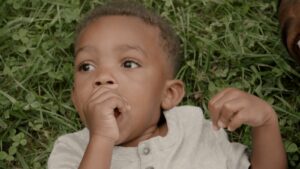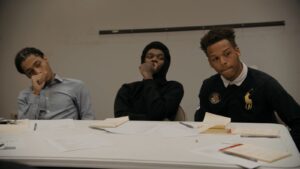Interview with “Black Boys” Director Sonia Lowman
Written by: Christopher Llewellyn Reed | October 24th, 2020

I had the wonderful opportunity, a few weeks ago, to remotely interview director Sonia Lowman about her moving and insightful documentary Black Boys (which I had previously reviewed). The movie examines persistent systemic racism in the United States and how it affects Black males, especially. Here is a condensed digest of our conversation, edited for length and clarity.
Christopher Llewellyn Reed: I’d like to first ask about your interest in the topic, since your previous film, Teach Us All, which I haven’t seen, also deals with systemic racism. What draws you to this?

Sonia Lowman: Well, I actually became a filmmaker by way of activism. I was working in education and educational non-profit and started learning about the inequalities in our school system, as well as the story of the Little Rock Nine. Teach Us All is set against the backdrop of the Little Rock school-desegregation crisis. I sort of conceptualized that first film, seeing that we were coming up on the 60th anniversary of that. We wanted to elevate the conversation about inequity and segregation. A film seems like a great way to talk about that and so I just sort of dove in and started making Teach Us All and I hadn’t made any films before. I didn’t have any experience.
So, for me, it’s actually not like I’m a filmmaker looking for content. I was an activist and then I felt filmmaking would be a good medium to elevate the activism. That was the intention. And so I was already very steeped in that, kind of looking at the racial injustices of our school system, connecting that to the criminal-justice system and some of the other stuff that was coming out.
And because Ava DuVernay acquired my film as a companion piece to 13th, I was obviously already thinking very deeply about the connections but also feeling like I wanted to go deeper into that because, at the time, it was 2017 and there was sports activism taking place; “take a knee” was in the headlines. And I just felt like you can’t really talk about Black boys and racial injustice and the killing of Black boys without bringing in sports, because I think sports is a continuum, as the film shows, of this sort of dehumanization, in many ways, and the commodification and just fixating on the body of Black men and boys rather than valuing their full humanity.
CLR: I found that part of your film that likened the sports drafts …
SL: The NFL Combine, especially, yeah.
CLR: … to slave auctions, really compelling and haunting. I hadn’t ever thought of that before. I’m not particularly a football person. I don’t really watch the drafts. Obviously, lots of people do. But I found that really chilling, actually, that comparison. And it makes a lot of sense.
SL: Yeah. And the same with me. I mean, I don’t think I’ve ever watched a football game in my life. And so I didn’t even know what the Combine was. But I could see, objectively, as a non-sports fan, I guess, that there was this … I could see the continuum very clearly. I mean, in the early sort of drafts of this writing about this film, it was like, “from the cotton fields to the football fields.” To me, that connection was very clear. But once I started learning about the Combine and the NCAA, I really started to see just how strange it is. And even when we went to Mart, Texas, for example, that segment that happens in there … I mean, it was a staggeringly poor community. But the young Black men there, they have extreme poverty but then they’ll have $300 Nike shoes that are brought to them by college recruiters. And it’s kind of haunting, if you will, to say the least.
CLR: As a white woman, what difficulties did you encounter, if any, in speaking to your African American subjects about race?
SL: I mean, of course every single person asks, “Why are you, a white woman, making this film?” Before I interviewed everybody, we would cross that bridge. I would talk about what was bringing me to this subject matter and my perspective on the topic. And so it was my honesty that really, I think, helped create the trust and the kind of environment to have very raw and vulnerable conversations. So, once I brought my own vulnerability and my own honesty to the conversation, which, in a nutshell, was about being a white woman who grew up in segregated environments and found myself fearing Black men for inexplicable reasons and wanting to de-condition that and unpackage that, it was such a … I think so many of the Black men and boys said: “Nobody’s ever admitted that to me. We feel it all the time. We see the way white people and white women in particular look at us, but nobody talks about it honestly. Nobody admits it.
And so I think that alone dissolved a lot of the barriers because we were able to actually have a very honest, frank conversation about race, which doesn’t happen a lot in this country. A lot of people will talk about racism as a problem but we kind of talk about it conceptually, like it exists “out there.” It’s the structural … it’s a systemic thing. And often we won’t take it to the very personal, very micro level. So it was honestly … there was an enormous amount of trust and willingness to talk about these things among Black people. If anything, there’s more resistance among white people, who say, “Well, who are you to tell the story?” They’re uncomfortable with the fact that I’m telling the story, whereas all the Black men and boys we worked with, and a lot of Black mothers and women we worked with, were like, “Thanks for being honest; thanks for talking about this in a real way.” But white people can be a little bit more uncomfortable with it.

CLR: You have a scene in your film where you are talking to a biracial young man about his experiences with white women, in which we see you in the room, yourself, though you don’t actually include an onscreen credit to identify yourself. Why did you decide to include yourself and why did you not identify yourself as the director? Later, after I looked you up online and saw your picture, I said, “Oh, that was Sonia Lowman!”
SL: The intention of the film is clearly to hear their perspective and their voices. And so it was very centered on them. The cameras were just trained on them and never on me. For whatever reason, when that young man, Tyrone, walked into the room … I have no idea why, I didn’t know him, but he came in, and he’s an athlete and he was cool … I don’t know why, but I just said to my cinematographer, I was like, “Mic me up,” for some reason. I don’t know why. It was an instinct. And then they put a camera on me. But it was the only interview where that happened. And that exchange with him happened, so it was captured, very authentically and very emotionally, in the moment.
And so, as a film person, yourself, you know that when you’re editing, it’s good to have two angles, so that you can cut between them. But we didn’t have the second angle of him because the second angle was on me. And so had we just had the camera on him, we would have just gone between the wide and the tight of him. I didn’t set out to be like, “This scene is going to have Sonia Lowman in it and it’s going to be an exchange about …” No, because that similar conversation happened with so many of the men and boys and I wasn’t on camera. So, I don’t know. It was just like one of those things that happened.
And then, in editing, we didn’t have a lot of choice. I guess we could have cut to B-roll or something, which felt weird, too. So it just so happened that it was such a powerful exchange, but we didn’t want to really focus on me. I don’t know why we didn’t identify me. I don’t know. It was just, I think, not to draw more attention to me. I don’t know.

CLR: For me, whether or not you’re identified, your inclusion as a white female interviewer, given that he is talking about white women’s reactions to him and how he has a white mother, which already makes that scene have so many layers, adds just another layer.
SL: Yeah. And of course, I didn’t know he had a white mother when he walked in. I didn’t know. We were at a conference for students, for a coalition of schools educating boys of color. And so we’d had a number of conversations with the organizers and the educators. And then they were kind of bringing in students they thought would be good. So, yeah, I didn’t know he was biracial, necessarily. I didn’t know he’d have that reaction to the question. It was just one of those moments. But yeah, it’s very layered, as you say.
CLR: So how did you connect with New Orleans Saints safety Malcolm Jenkins, who’s so powerful in the film? He’s both a subject and a producer.
SL: We actually had that connection through Dr. John King, who is the former Secretary of Education under Obama. And he’s a big champion of the film. We’d been working with him throughout the process, as well. And so it was his chief of staff who said, “Would you want to talk to Malcolm Jenkins?” And I was like, “Sure.” And so at first it was just an interview, and then he wanted to get more involved and came on as an executive producer and even flew out to L.A. when I was editing, at one point, and sat with me in the editing room and we talked really, really deeply. This was sort of maybe three quarters of the way through editing, and I got his perspective on where we were, so far. He’s been incredible. But it all came through John King and The Education Trust.
CLR: So how did you get to John King?
SL: Well, because of Teach Us All. A woman I know, who loved the film, sent it to him and it speaks to the work he does, as well.
CLR: Were there any people that you approached to be in the film, that you really wanted to be in the film, who declined?
SL: (laughs) Speaking of a white woman, we really wanted to talk to Brene Brown, because I thought her research on vulnerability and belonging is so relevant to this. I mean, the core of this film is about belonging, to me, or that sense of not belonging, in a way. And I love her research. I mean, her team’s been really nice and supportive but it didn’t work out. We were going to try to fly to Texas … it’s a whole thing.
But I don’t know what that would’ve looked like, in retrospect. It would have been sort of an interesting, different project. But yeah, I mean, I’m sure there are people who said no. I definitely wanted to have more musicians and rappers. I can’t remember who we approached but I think Chance the Rapper would have been cool. And I don’t know if it was ever a “no” because I don’t even think we got that close to him, but there was certainly a wishlist and we didn’t get to everybody on that wishlist.

CLR: You have this structure with different sections labeled “Body,” “Mind,” “Voice” and “Heart.” How did you come up with that structure and how do you think that structure informs the discussion?
SL: Well, the thesis of the film is really that we often only see Black men and boys through their body, whether it’s valuing them for their body or devaluing them for their body, in a way. But also I talk about how there’s this sort of two-dimensional depiction of Black men in media often, where it feels like they’re very kind of like flattened almost, if they’re not fully dimensional. And so the intention of the film is to illuminate the full spectrum of Black male humanity, starting with the body, which is usually where most people kind of stop and then wanting to kind of … I’m a yoga person, so I see the chakras. And so the structure we set up was to talk about these different parts of our fuller humanity.
CLR: I’m curious how you found those three high-school boys. They’re so much fun and so smart. I especially love when they’re talking about Coco. I mean, they say a lot of great things, but that was so charming and genuine, when they’re talking about Coco, which incidentally is a film I also cried during … in one of the same moments that they talk about.
SL: (laughs) That’s funny. Well, yeah, I mean, the thing, I think, that makes this really special and not only … I mean, we worked so much with organizations. I call it a co-creation. It wasn’t like, “Sonia Lowman wants to talk about racism.” It was, “We want to hear what everybody who’s already in this space is doing.” And so, all of the young people that we spoke with really came through these partner organizations. That one, in particular, was Chris Chapman, who was in Oakland. He works in the Oakland Unified School Districts program for African American Male Achievement, which is an incredible program.
And so there was an enormous amount of trust and organic nature to this. And they were Chris’s students. We had a long number of conversations with Chris and we asked about students we could speak to. I had a pre-interview with them over Zoom. This was pre-COVID, but it was Zoom. And then we went up there and that was just them, just being themselves. But they came through this incredible program where they really are mentored and talk about these issues a lot. They talk about identity and purpose and having your voice and shaping your narrative and all of these things.
CLR: Well, I want to thank you so much for talking to me. I really enjoyed the film.
SL: Thank you so much for your support!

